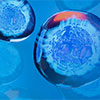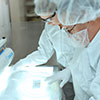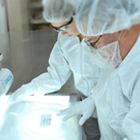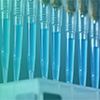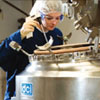Eiwitten en peptiden
Itemnummer:
(PRSI5737P)
Leverancier:
ProSci Inc.
Omschrijving:
APC11 peptide is used for blocking the activity of APC11 antibody.
UOM:
1 * 50 µG
Itemnummer:
(PRSI91-210)
Leverancier:
ProSci Inc.
Omschrijving:
U6 snRNA-associated Sm-like protein LSm4 (LSM4) is a member of the snRNP Sm proteins family. Sm-like proteins contain the Sm sequence motif and are thought to form a stable heteromer present in tri-snRNP particles, which are important for pre-mRNA splicing. LSM4 forms a heteromer with a donut shape. The complexes are involved in various steps of RNA metabolism. LSM4 binds specifically to the 3-terminal U-tract of U6 snRNA. LSM4 contributes RNA protein interactions and structural changes which are essential during ribosomal subunit assembly.
UOM:
1 * 50 µG
Itemnummer:
(PRSI91-215)
Leverancier:
ProSci Inc.
Omschrijving:
L-Lactate Dehydrogenase A Chain (LDHA) is an enzyme that catalyzes the conversion of L-lactate and NAD+ to pyruvate and NADH in the final step of anaerobic glycolysis. LDHA contains an N-terminal coenzyme binding region, a central catalytic site, and at least nine utilized Lys acetylation and two Tyr phosphorylation sites. LDHA belongs to the lactate dehydrogenase family, expressed predominantly in muscle tissue. LDHA mutations have been linked to exertional myoglobinuria.
UOM:
1 * 50 µG
Itemnummer:
(PRSI91-216)
Leverancier:
ProSci Inc.
Omschrijving:
L-Lactate Dehydrogenase B Chain (LDH-B) is a member of the lactate dehydrogenase family that consists of three members, LDH-A, LDH-B and LDH-C; members of this family function as powerful markers for germ cell tumors. LDH-B is an oxidoreductase that catalyzes the interconversion of pyruvate and lactate with concomitant interconversion of NADH and NAD+. It converts pyruvate to lactate when oxygen is absent or in short supply and it performs the reverse reaction during the Cori cycle in the liver. It is also called Hydroxybutyrate Dehydrogenase (HBD) due to its ability to catalyze the oxidation of hydroxybutyrate.
UOM:
1 * 50 µG
Itemnummer:
(PRSI91-219)
Leverancier:
ProSci Inc.
Omschrijving:
Neurocalcin-delta (NCALD) is a neuronal calcium-binding protein that belongs to the neuronal calcium sensor (NCS) family. It expressed in mammalian brains. NCALD contains an N-terminal myristoylation signal and four EF-hand calcium binding loops. The protein possesses a Ca2+ /myristoyl switch. It is cytosolic at resting calcium levels. However, elevated intracellular calcium levels induce a conformational change which exposes the myristoyl group, resulting in protein association with membranes and partial co-localization with the perinuclear trans-golgi network. NCALD protein is thought to be a regulator of G protein-coupled receptor signal transduction.
UOM:
1 * 50 µG
Itemnummer:
(PRSI91-982)
Leverancier:
ProSci Inc.
Omschrijving:
Actins are ubiquitous globular and highly conserved proteins that are involved in various types of cell motility, structure, and integrity. Three main groups of actin isoforms, alpha, beta and gamma have been identified. The alpha actins are found in muscle tissues and are a major constituent of the contractile apparatus. The beta and gamma actins co-exist in most cell types as components of the cytoskeleton, and as mediators of internal cell motility. ACTB is a major constituent of the contractile apparatus and one of the two nonmuscle cytoskeletal actins. Polymerization of globular actin (G-actin) leads to a structural filament (F-actin) in the form of a two-stranded helix. Each actin can bind to 4 others.
UOM:
1 * 50 µG
Itemnummer:
(PRSI91-605)
Leverancier:
ProSci Inc.
Omschrijving:
Natural cytotoxicity triggering receptor 1(NCR1) is a single-pass type I membrane protein .It contains 2 Ig-like (immunoglobulin-like) domains and belongs to the natural cytotoxicity receptor (NCR) family. The protein is a natural killer (NK) lymphocyte-activating receptor. It is involved in major aspects of NK immune function and shows a high degree of lineage specificity in blood and bone marrow.
UOM:
1 * 50 µG
Itemnummer:
(PRSI91-683)
Leverancier:
ProSci Inc.
Omschrijving:
cGMP-Dependent Protein Kinase 1 (PRKG1) belongs to the protein kinase superfamily and AGC Ser/Thr protein kinase family. PRKG1 contains one AGC-kinase C-terminal domain, two cyclic nucleotide-binding domains, and one protein kinase domain. PRKG1 is mainly expressed in the lung and placenta. PRKG1 acts as a key mediator of the nitric oxide (NO)/cGMP signaling pathway. PRKG1 can phosphorylate many proteins that regulate platelet activation and adhesion, smooth muscle contraction, cardiac function, gene expression, feedback of the NO-signaling pathway, and other processes involved in several aspects of the CNS like axon guidance, hippocampal and cerebellar learning, circadian rhythm, and nociception.
UOM:
1 * 50 µG
Itemnummer:
(PRSI90-281)
Leverancier:
ProSci Inc.
Omschrijving:
IL-36Ra/IL-1F5 is a highly and a specific antagonist of the IL-1 receptor-related protein 2-mediated response to IL-36alpha (IL-1F6), IL-36beta (IL-1F8) and IL-36gamma (IL-1F9). These cytokines bind to IL-36R (IL-1Rrp2) and IL-1RAcP, activating similar intracellular signals as IL-1. IL-36Ra inhibits the production of proinflammatory cytokines, including IL-12, IL-1beta, IL-6, TNF-alpha and IL-23 induced by IL-36 in BMDC and CD4 T cells. Skin and dendritic cells are target of the IL-36 interleukins leading to a Th1 response. Recently mutations that affect the levels and the activity of IL-36Ra have been found in patients with pustular psoriasis, leading to enhanced production of inflammatory cytokines (IL-8 in particular) by keratinocytes.
UOM:
1 * 1 EA
Itemnummer:
(PRSI92-465)
Leverancier:
ProSci Inc.
Omschrijving:
Semaphorin-4G is belongs to the semaphorin family, contains 1 Ig-like C2-type domain, 1 PSI domain, 1 Sema domain. Semaphorins are a large family of conserved secreted and membrane associated proteins which possess a semaphorin (Sema) domain and a PSI domain (found in plexins, semaphorins and integrins) in the N-terminal extracellular portion. Based on sequence and structural similarities, semaphorins are put into eight classes: invertebrates contain classes 1 and 2, viruses have class V, and vertebrates contain classes 3-7. Semaphorins serve as axon guidance ligands via multimeric receptor complexes, some (if not all) containing plexin proteins. This gene encodes a class 4 semaphorin.
UOM:
1 * 50 µG
Itemnummer:
(PRSI92-468)
Leverancier:
ProSci Inc.
Omschrijving:
Semaphorin-4C is a protein which belongs to the semaphorin family, contains 1 Ig-like C2-type domain, 1 PSI domain, 1 Sema domain. As cell surface receptor for PLXNB2, it plays an important role in cell-cell signalling. PLXNB2 binding promotes downstream activation of RHOA and phosphorylation of ERBB2 at 'Tyr-1248'. It required for normal brain development, axon guidance and cell migration, Probable signalling receptor which may play a role in myogenic differentiation through activation of the stress-activated MAPK cascade.
UOM:
1 * 50 µG
Itemnummer:
(PRSI91-055)
Leverancier:
ProSci Inc.
Omschrijving:
The Galectin family of proteins, with specificity for Nacetyllactosamine containing glycoproteins, consists of beta-galactoside binding lectins containing homologous carbohydrate recognition domains (CRDs).They also possess hemagglutination activity, which is attributable to their bivalent carbohydrate binding properties. Galectins are active both intracellularly and extracellularly. Although they are localized primarily in the cytoplasm and lack a classical signal peptide; they can be secreted by one or more as yet unidentified non-classical secretory pathways. They have diverse effects on many cellular functions including adhesion, migration, polarity, chemotaxis, proliferation, apoptosis, and differentiation. Galectins may play a key role in many pathological states, including autoimmune diseases, allergic reactions, inflammation, tumor cell metastasis, atherosclerosis, and diabetic complications.
UOM:
1 * 50 µG
Itemnummer:
(PRSI91-634)
Leverancier:
ProSci Inc.
Omschrijving:
Interleukin 25 (IL-25) belongs to the Interleukin 17 (IL-17) family of proteins, which is comprised of six members (IL-17, IL-17B through IL-17F). These proteins are secreted and are structurally related by sharing a conserved cysteine-knot fold near the C-terminus, but have considerable sequence divergence at the N-terminus. With the exception of IL-17B, which exists as a non-covalently linked dimer, all IL-17 family members are disulfide-linked dimers. IL-17 family proteins are pro-inflammatory cytokines that induce local cytokine production and are involved in the regulation of immune functions. Human interleukin-17E (IL17E), also referred to as Interleukin-25 (IL25), is a distinct member of the IL17 cytokine family comprised of at least six members sharing a conserved cysteine-knot structure but divergent at the N-terminus. IL25 is a glycoprotein secreted as dimers by innate effector eosinophils and basophils, and present at very low levels in various peripheral tissues. IL25, together with IL17B, are ligands for the cytokine receptor IL17BR, and the cross-linking induces NF-κB activation and production of the proinflammatory chemokine IL-8, as well as ERK, JNK, and p38 activation. Overexpression of IL25 gene in transgenic mice suggested that this cytokine can regulate hematopoietic and immune functions, and additionally is identified as a proinflammatory cytokine favoring Th2-type immune responses possibly by enhancing the maintenance and functions of adaptive Th2 memory cells.
UOM:
1 * 50 µG
Itemnummer:
(PRSI91-676)
Leverancier:
ProSci Inc.
Omschrijving:
Putative polypeptide N-acetylgalactosaminyltransferase-like protein 1, also known as Polypeptide GalNAc transferase-like protein 1, Protein-UDP acetylgalactosaminyltransferase-like protein 1, UDP-GalNAc:polypeptide N-acetylgalactosaminyltransferase-like protein 1, GalNAC-T-like protein 1, pp-GaNTase-like protein 1 and GALNTL1, belongs to the glycosyltransferase 2 family. GALNTL1 plays an important role in the protein modification and protein glycosylation process. GALNTL1 uses the manganese and calcium ion as a cofactor, may catalyze the initial reaction in O-linked oligosaccharide biosynthesis, transfers the N-acetyl-D-galactosamine residue to a serine or threonine residue on the protein receptor.
UOM:
1 * 50 µG
Itemnummer:
(PRSI92-026)
Leverancier:
ProSci Inc.
Omschrijving:
Karyopherin Subunit alpha-2 (KPNA2) belongs to the importin alpha family. KPNA2 is widely expressed in many tissues and contains an N-terminal hydrophilic region, a hydrophobic central region composed of 10 repeats, and a short hydrophilic C-terminus. KPNA2 interacts with the NLSs of DNA helicase Q1 and SV40 T antigen and may be involved in the nuclear transport of proteins. KPNA2 also may play a role in V(D)J recombination. KPNA2 functions in nuclear protein importantly as an adapter protein for nuclear receptor KPNB1.
UOM:
1 * 50 µG
Itemnummer:
(PRSI7281P)
Leverancier:
ProSci Inc.
Omschrijving:
17 amino acids near the carboxy terminus of human MTERFD1.
UOM:
1 * 50 µG
Bel voor prijs
De voorraad voor dit item is beperkt, maar kan beschikbaar zijn in een kortbijgelegen magazijn. Gelieve te controleren of u bent aangemeld op de site zodat de beschikbare voorraad weergegeven kan worden. Als het
De voorraad voor dit item is beperkt, maar kan beschikbaar zijn in een kortbijgelegen magazijn. Gelieve te controleren of u bent aangemeld op de site zodat de beschikbare voorraad weergegeven kan worden. Als het
Dit product is gemarkeerd als beperkt en kan enkel gekocht worden door goedgekeurde verzendingsaccounts. Als u hulp nodig heeft gelieve dan het VWR-Regelgevend Departement te contacteren via regulatory_affairs@vwr.com.
Bijkomende documentatie kan noodzakelijk zijn voor dit item. Een VWR-verantwoordelijke zal contact opnemen met u indien nodig.
Producten die gemarkeerd zijn met dit symbool werden geblokkeerd door uw organisatie. Gelieve contact op te nemen met uw aankoopafdeling
Het originele artikel is niet langer beschikbaar. Het getoonde alternatief is wel beschikbaar.
Product(en) met dit symbool worden binnenkort niet meer verkocht - verkoop tot het einde voorraad. Alternatieven zijn mogelijk beschikbaar door te zoeken met het VWR artikelnummer dat hierboven wordt vermeld. Neem voor meer informatie contact op met onze Customer Service op 016 385 011.
|
|||||||||




